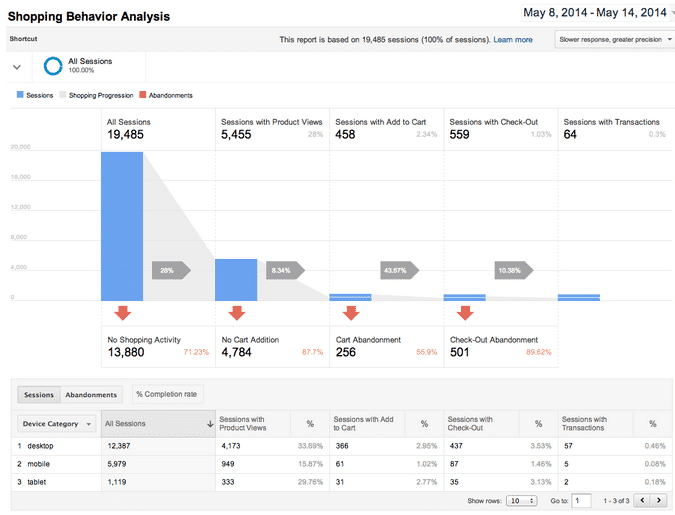Marketing Analytics Strategist
Google Analytics Summit 2014: What's New?
Marketing Analytics Strategist
Adviso and all the other certified Google Analytics partners were invited to San Francisco to attend the annual summit which took place on May 28 and 29, 2014. The theme of this summit was: “Data in Action”. This theme reflects very well a continuation of Google's latest efforts, since the announcement of Universal Analytics, to want to transform Google Analytics into a tool capable of processing data from different sources quickly, in order to be able to have a 360 degree view of users of a website or application.
SO WHAT ARE THE LATEST ANNOUNCEMENTS? HERE THEY ARE:
1) Enhanced Ecommerce
2) Data import
3) Unified Channel Groups
4) Custom tables
5) Integration with DoubleClick Digital Marketing Platform
6) 4 new APIs
1) REDESIGN OF E-COMMERCE IN GOOGLE ANALYTICS (ENHANCED COMMERCE)
Probably the biggest announcement from this summit is the e-commerce reporting update in Google Analytics. Since the creation of these reports, the tracking of online purchases has always been done on the last page of the purchase funnel only. The only data available was about a purchase: product name, number of transactions, price, category, quantity, taxes, shipping costs, and others. The problem with this way is that it was absolutely necessary that a transaction take place to analyze the performance of an online shopping site. Unless you used an advanced and complicated setup that included the use of events or virtual pageviews, it was impossible to measure the purchase funnel for visitors who didn't convert. On average, 67.91% of visitors who add a product to the cart end up abandoning it . So we can say that with the current e-commerce reports, Google Analytics would not even inform us if 7 out of 10 visitors (or so) filled the basket, and left a site without buying anything.

With Enhanced Commerce , which will work with Universal Analytics only , it will now be possible to measure the number of visitors who see a product, how many add it to a cart, how many checkout, how many decide to add complementary products ( related products ) while they are at checkout, and how many make a confirmed purchase. As you can see in the image above, we're going to have a new funnel to track our visitors every step of the way. The difference between this funnel and the old one is that the old one was not only less informative, but it required that at least one transaction (or rather a goal) had taken place in order to work. The other important novelties in this regard are as follows:
- Refunds : it will be possible to import refunds on previous online purchases, and Google Analytics will do the reconciliation automatically (using the 'transaction id') in order to close the loop.
- Segments & Remarketing : based on the activities of visitors to an online shopping site, it will be possible to create segments that can be used in a Remarketing list. For example, you could create a segment on visitors who filled the cart with a specific product without buying anything, who use a tablet, and add them to a Remarketing list. Note that you will be able to apply these segments in any other report as well.
- Data import : as with Google Merchant Center, it will be possible to manually import (with a csv file for example) a detailed list of your products sold online directly into the Google Analytics interface. The advantages are that you will be able to import unique dimensions to your online store, and have the option of modifying the names and/or prices of your products later. These changes will be updated in your Google Analytics reports automatically.
- Integration with Google Tag Manager : Yes, you will be able to configure these new eCommerce features through Google Tag Manager. In the next few weeks, you should see “Ecommerce Features (beta)” appear under the “More settings” section of a GTM tag.
Enhanced Commerce will be available in all Google Analytics accounts (standard and premium) in the coming weeks. For those interested, Analytics Academy has even created this special course on this topic .
2) DATA IMPORT
Google Analytics has also expanded the features related to data import. Importing data is nothing new, for more than a year, it is possible to import cost data from Bing/Yahoo campaigns for example. Here is the latest list of new dataset types that you will be able to import:
- Cost data : Import data from non-Google marketing campaigns to calculate ROI directly into Google Analytics. This type is already available in the majority of accounts.
- User Data : Import user data such as customer segment, customer value, or contract renewal month. The availability of this type of data set is only available with Universal Analytics, and should appear in all accounts over the next few months. Also note that it is still forbidden to import personal data with this type.
- Product data : Import product metadata such as brand, category, variant, or custom product data. Availability of this type of data set is only available with Universal Analytics and Enhanced Ecommerce, and should appear in all accounts over the next few months.
- Campaign Data : Import campaign metadata such as source, medium, content, referral path, or custom campaign data. The availability of this type of data set is only available with Universal Analytics, and should appear in all accounts over the next few months.
- Refund data: Import refund data for online transactions (read above). The availability of this type of data set is only available with Universal Analytics, and should appear in all accounts over the next few months.
- Content Data : Import content metadata such as post, author, or category. The availability of this type of data set is only available with Universal Analytics, and should appear in all accounts over the next few months.
- Custom data : Create a custom dataset to import data to your specific needs, and which is not one of the types mentioned above.
3) UNIFIED CHANNEL GROUPS
You may have already noticed the option to set and change the channel grouping (direct, organic, social) that comes by default, and can be found under the "View" column in your Google Analytics account. You should also be aware of the “Multi-Channel Funnels” channel group found in the Multi-Channel Funnels reports. The news about this is that soon these two groups of channels will be unified, and can be customized in one place. The goal is to standardize channel groupings in Acquisition and Multi-Channel Funnels reports.
4) CUSTOM TABLES
The sampling of data in standard or custom reports is one of the biggest drawbacks of Google Analytics. We all dream of the day when we no longer have sampled data. Google is aware of this problem, and is making the necessary efforts to resolve it as soon as possible. In the meantime, Google Analytics announces " Custom Tables " for its Premium customers only. Custom Tables will allow the creation of a table of non-sampled data (from the Google Analytics interface), with a limited combination of metrics and dimensions. Subsequently, some custom reports will be able to pull their data from this table much faster, and especially without any sampling.
5) INTEGRATION WITH DOUBLECLICK DIGITAL MARKETING PLATFORM
One of the significant new features is the integration of DoubleClick Campaign Manager and DoubleClick Bid Manager with Google Analytics Premium only. The purpose behind this integration is to allow advertisers who have display campaigns on the DoubleClick platform, to have a more global view on the influence that display campaigns can have on conversions and different channels. For example, you will be able to compare the impact on conversions between View-through and Click-through of your campaigns in Google Analytics Premium. And as is already the case with Google Adwords, auto -tagging of display campaigns will soon be possible between DoubleClick and Google Analytics Premium. ; no need to add custom campaign parameters to your URLs manually. Finally, it will also be possible to share Remarketing lists with DoubleClick , as with Adwords, from a Google Analytics Premium property.
6) 4 NEW APIS
For those of you who hate doing repetitive tasks, know that Google Analytics will offer 4 new APIs to help you save time and increase your productivity. These new APIs are as follows:
1) Provisioning API : allows you to create new GA accounts programmatically. At this time, this API is available by invitation.
2) Management API (Adwords Links): allows you to create, modify, or delete links between Google Adwords accounts and Google Analytics properties/views with a few lines of code.
3) Management API (Filters): allows you to create, modify, or delete filters in one or more Google Analytics views in a few seconds. It's very common to have to create the same filters in several different accounts, so I imagine this API will be welcomed with open arms.
4) Embed API : Allows you to create and embed Google Analytics dashboards into any site or web page in minutes. This API could be very useful for comparing dashboards of different Google Analytics properties/views on the same webpage.
CONCLUSION
The main message that I took away from the GA Summit 2014 is that Google continues to make the necessary efforts to close the loop between online and offline from a marketing point of view. There are several features that are still confidential, but I think the ones mentioned above are enough for you to experiment little by little. Don't make the mistake of trying everything at once. Instead, take the opportunity to redefine your business goals, and see how you can achieve them faster with all these new features.
Your turn. What do you think of all these novelties? Is there a specific feature you'd like us to elaborate on in another post? Please answer in comments.

-1.png)
-1.png)
-2.png)





